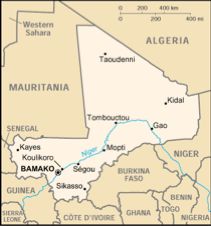Zanfina School Completed on January 29, 2011!
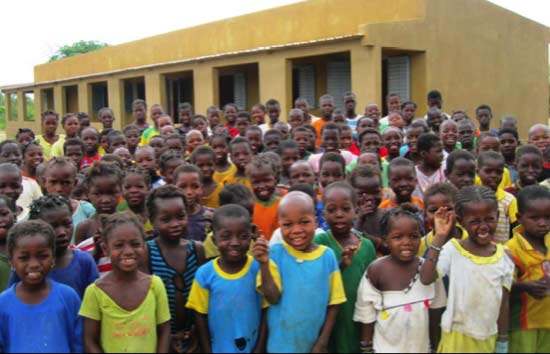
Children in front of their new school!
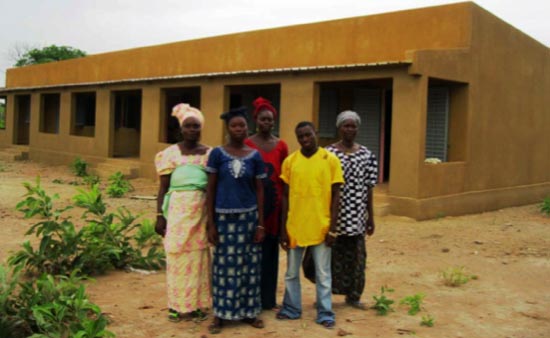
The Faculty….

The School Latrine

The Completed School
This Zanfina school project broke ground on November 22nd, 2010 and was completed on January 29th, 2011. During these 10 weeks of construction the people of Zanfina contributed a total of 2,557 volunteer workdays to the project, exceeding their goal and finishing ahead of schedule.
The new school block in Zanfina has three cinderblock classrooms. The students began attending classes in the school as soon as it was completed, and shortly thereafter in March, the adults enrolled in the Community Education Program (“CEP”). The CEP provides fundamental numeracy and literacy skills, as well as new knowledge about nutrition, family planning and income generating activities. The ability to read, write and do basic math allows individuals in the community to improve health conditions, develop more efficient farming techniques, and gain a stronger voice in society. buildOn selected two educated villagers from Zanfina to attend a 30-day facilitator training program earlier this year, where they received intensive instruction on how to teach adults to read and write. Facilitators receive a monthly stipend to teach 50-75 adults six nights per week, two hours a night for six months each year (villagers take school breaks during farming and holiday seasons) over a three year period.
The new school block in Zanfina has three cinderblock classrooms. The students began attending classes in the school as soon as it was completed, and shortly thereafter in March, the adults enrolled in the Community Education Program (“CEP”). The CEP provides fundamental numeracy and literacy skills, as well as new knowledge about nutrition, family planning and income generating activities. The ability to read, write and do basic math allows individuals in the community to improve health conditions, develop more efficient farming techniques, and gain a stronger voice in society. buildOn selected two educated villagers from Zanfina to attend a 30-day facilitator training program earlier this year, where they received intensive instruction on how to teach adults to read and write. Facilitators receive a monthly stipend to teach 50-75 adults six nights per week, two hours a night for six months each year (villagers take school breaks during farming and holiday seasons) over a three year period.
During this school building, we saw that women can do whatever men can do. We learned how to sift sand and gravel, how to properly mix cement and concrete, the number of bricks one can get from one sack of cement...how the mason lines the foundation, how to tie rebar, how to know the level of the bricks in the foundation and how to set the rebar in the foundation and paint the school.
Seydou Sangare, farmer and vice president of the school committee, age 49
With this school, kids will get education in better conditions, they won’t have to take classes in people’s sleeping houses; this will better motivate and encourage kids and also parents to send their kids to school. Classrooms are no longer spread out in the village. Being in the same school yard will help us, the teachers, to have more control over the kids. This new school will improve the quality of education in this community.
Assetou Kone, Headmistress, age 43
I would like to say thank you to the donors for their invaluable and great help and to buildOn for their hard work and for bringing light in this village. All our kids will get an education in their own village, boys and girls. Thank you for improving the condition and the quality of education in our community. We keep praying God and making blessings for you guys. May God bless you!
Abi Togola, housewife, age 41
Zanfina Community Profile
The village of Zanfina is a decentralized community located in the municipality of Koumantou, 85 km from the buildOn office in Bougouni and 10 km away from the main road. The population is estimated at 550 people living in 24 families. The community belongs to the ethnic group Fulani, which is one of the largest ethnic groups in Mali. These people are also known as shepherds in Mali.
Mostly uneducated, the population survives through subsistence farming and livestock breeding. Millet, rice, corn, peanut, cotton and other cereal farmlands surround the village. There is an adequate supply of drinking water (3 pumps) and there is no disease in the community. The villagers of Zanfina are known for their warmth and hospitality and are living on good terms with all of their neighbors.
Mostly uneducated, the population survives through subsistence farming and livestock breeding. Millet, rice, corn, peanut, cotton and other cereal farmlands surround the village. There is an adequate supply of drinking water (3 pumps) and there is no disease in the community. The villagers of Zanfina are known for their warmth and hospitality and are living on good terms with all of their neighbors.
Prior School Conditions
The former classrooms in the community are made of mud and need to be plastered up every year after the rainy season to allow classes to start. One of these classrooms was constructed by the community in collaboration with CRADE (a national nongovernmental organization) in 1998. The nearest village with a permanent school is Banco, 5km away, where buildOn supported the construction of a 3- classroom school block in 2007. The community is eager to complete their first permanent school building and participate in the Community Education Program for adults next year.
The New School Project
The people of Zanfina broke ground on their school on November 22, 2010! Dauda Diakite, head of the school committee, said in his speech on that day: “Today, we realize that education is the only way to escape from the mind’s darkness. It reduces illiteracy and opens the door to development.”
Prior to beginning construction, the villagers had already collected sufficient quantities of sand and gravel to complete the entire project. As the school progressed the learned construction techniques and best practices from the buildOn skilled labor team, keep a daily inventory of supplies and spend many hours and days working together towards their common goal. The 3- classroom school block took approximately 12 weeks to complete.
Prior to beginning construction, the villagers had already collected sufficient quantities of sand and gravel to complete the entire project. As the school progressed the learned construction techniques and best practices from the buildOn skilled labor team, keep a daily inventory of supplies and spend many hours and days working together towards their common goal. The 3- classroom school block took approximately 12 weeks to complete.
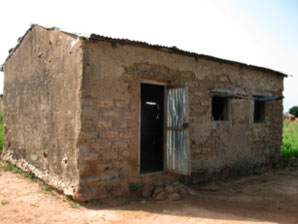
Front of the Existing School
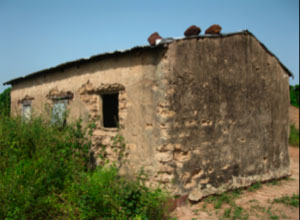
Rear of the Existing School
Community Contribution
• Unskilled labor: 30 workers (15 men and 15 women) per day, six days per week
• The land on which the school is built
• High quality local materials: sand, gravel, water & rocks
• Project management: a committee made up of 12 villagers (six men, six women) • Lodging for buildOn team: Field Coordinator and skilled laborers
• Basic construction tools (shovels, picks, wheelbarrows, buckets, etc.)
• Commitment to educating boys and girls equally
buildOn Contribution
• Construction materials (excluding local materials) for school and latrine
• Skilled labor and plans needed to build the school
• Project management (buildOn coordinators)
• Instruction in basic construction techniques
• Unskilled labor: 30 workers (15 men and 15 women) per day, six days per week
• The land on which the school is built
• High quality local materials: sand, gravel, water & rocks
• Project management: a committee made up of 12 villagers (six men, six women) • Lodging for buildOn team: Field Coordinator and skilled laborers
• Basic construction tools (shovels, picks, wheelbarrows, buckets, etc.)
• Commitment to educating boys and girls equally
buildOn Contribution
• Construction materials (excluding local materials) for school and latrine
• Skilled labor and plans needed to build the school
• Project management (buildOn coordinators)
• Instruction in basic construction techniques
